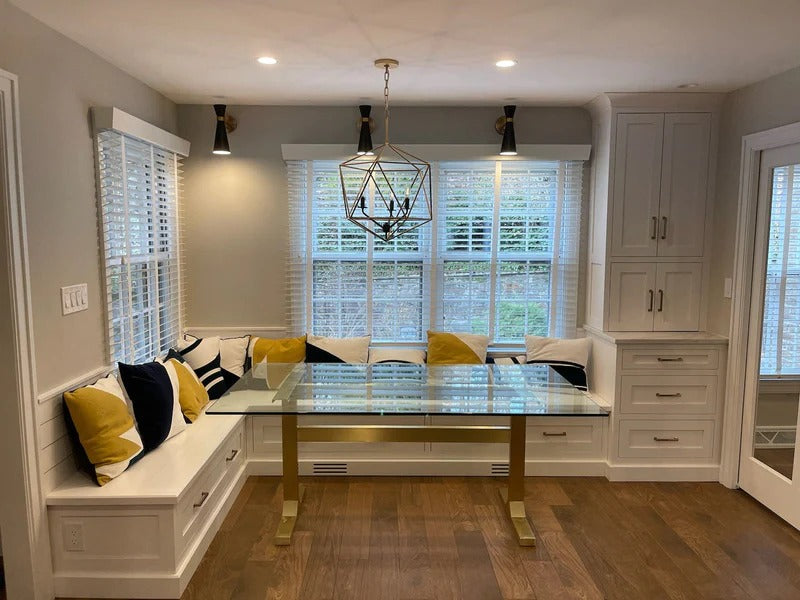
Brass is having a moment—and it’s not just a trend. From boutique hotels in Miami to high-end residential interiors in New York and California, interior designers are turning to brass for its warmth, character, and timeless appeal.
But what makes brass such a favorite? And why is it showing up everywhere from kitchen islands to coffee tables and custom furniture legs?
Let’s explore why designers are choosing brass—and where you can find the best handcrafted pieces for your next project.
1. Brass Adds Warmth Without Overpowering the Space
Unlike chrome or stainless steel, brass gives off a softer, golden glow. It balances modern minimalism with a touch of old-world luxury, making it ideal for contemporary interiors that still want to feel lived-in.The golden undertones create an inviting atmosphere that designers use to make large spaces feel more intimate.
Designers love using our AYLA Brass Coffee Table Base to add subtle glamour without overdoing it.
🛠️ 2. It’s Durable and Versatile
Solid brass isn’t just beautiful—it’s strong. That’s why many professionals use it for structural and statement pieces alike.
Our customers often choose Kitchen Island Leg / BRASS DIZDAR 01 for residential and commercial kitchens that demand both style and strength.
3. Brass Elevates the Ordinary
Even the simplest shape feels premium when finished in brushed or polished brass. A basic cabinet or table suddenly becomes a design feature.
If you want to upgrade a space effortlessly, check out our handcrafted Wings Brass Furniture Legs that work beautifully for sofas, vanities, and storage benches.
4. It Works Across Styles
Whether your project leans industrial, coastal, Scandinavian, or art deco—brass fits in. Interior designers love its chameleon-like quality. It can look vintage or ultra-modern depending on the finish.
Interior designers love brass because it adapts to any aesthetic:
- Modern Minimalist: Brushed brass with clean lines
- Traditional: Polished brass with ornate details
- Industrial: Raw brass with exposed construction
- Bohemian: Antique brass with vintage appeal
We offer a wide range of custom options including:
-
Polished Brass
-
Brushed Brass
-
Matte Finish
-
Aged Patina
→ Explore the full Balasagun Brass Collection
5.Reflects Light to Brighten Interiors
Brass material acts as a natural light reflector, helping interior designers brighten dark spaces without adding more fixtures. The warm reflection of brass creates a golden hour effect throughout the day.
Designer Strategy: Place brass elements strategically to bounce natural light around rooms and create depth.
6. Designers Trust the Craftsmanship
Designers value precision, proportion, and finish. That’s why they choose custom brass legs from trusted makers who understand both form and function.
At Balasagun, we’ve been crafting metal furniture legs since 2013—offering tailored solutions that interior designers depend on.
🛒 Ready to Bring Brass into Your Next Design?
Here are some top picks:
. Brass Table Legs , 28" X 28" X 25" Dining Trestle Table Legs
Have a custom idea or project in mind? Let’s talk!






Leave a comment
Also in Edit By Balasagun
The Complete Guide to Metal Desk Table Legs: Strength, Design, and Quality Manufacturing
August 19, 2025
Continue reading
The Art of Metal: Inside Balasagun's Decade of Craftsmanship
May 07, 2025
Since 2013, Balasagun has been dedicated to perfecting the art of metal furniture components. As we've grown to serve clients across the United States and Canada, our commitment to quality craftsmanship has remained unwavering. Today, we invite you behind the scenes to discover what makes Balasagun table legs and furniture components truly exceptional.
Continue reading
Stainless Steel Shines at Milan Design Week 2025: A Reflective Design Trend
April 23, 2025
A New Material Language
Milan Design Week 2025 introduced a new kind of clarity in interior aesthetics — one shaped by reflective surfaces, precise forms, and material honesty. Stainless steel emerged not as an accent, but as a statement: luminous, architectural, and uncompromising. Across installations and collections, designers explored how light interacts with metal — not for shine alone, but to sculpt space, texture, and depth. What stood out was the seamless integration of these industrial elements with tactile, organic materials.
Continue reading